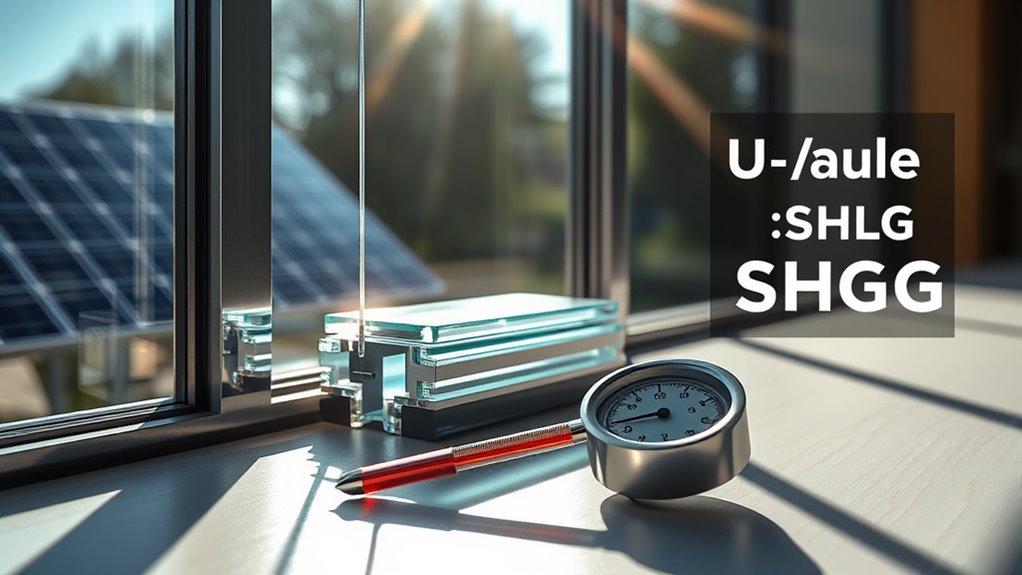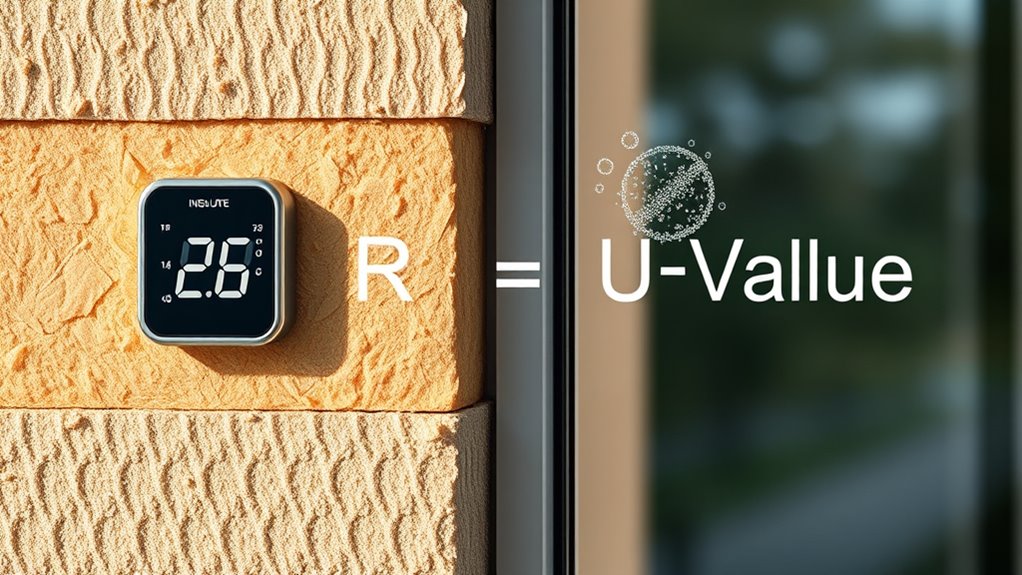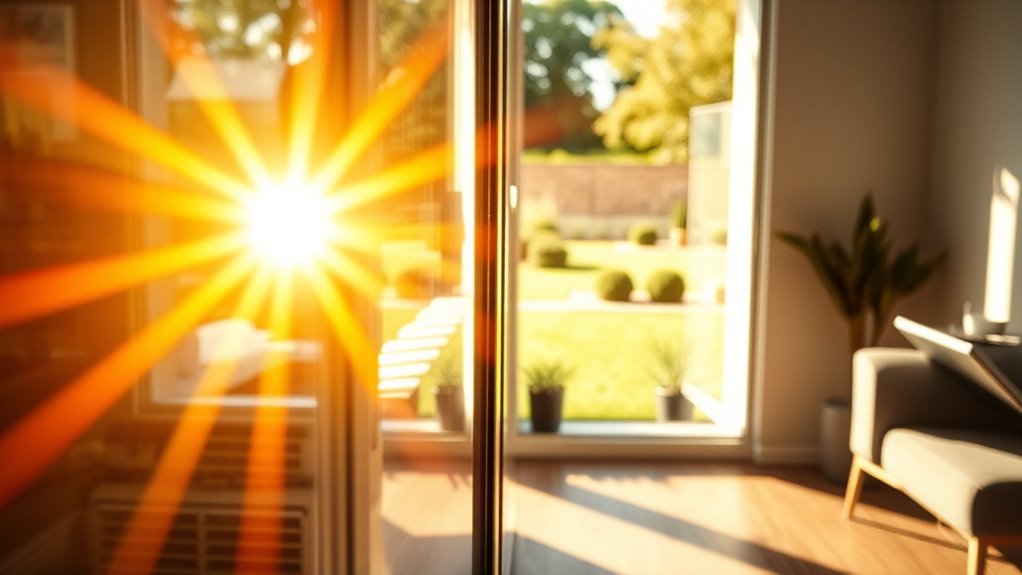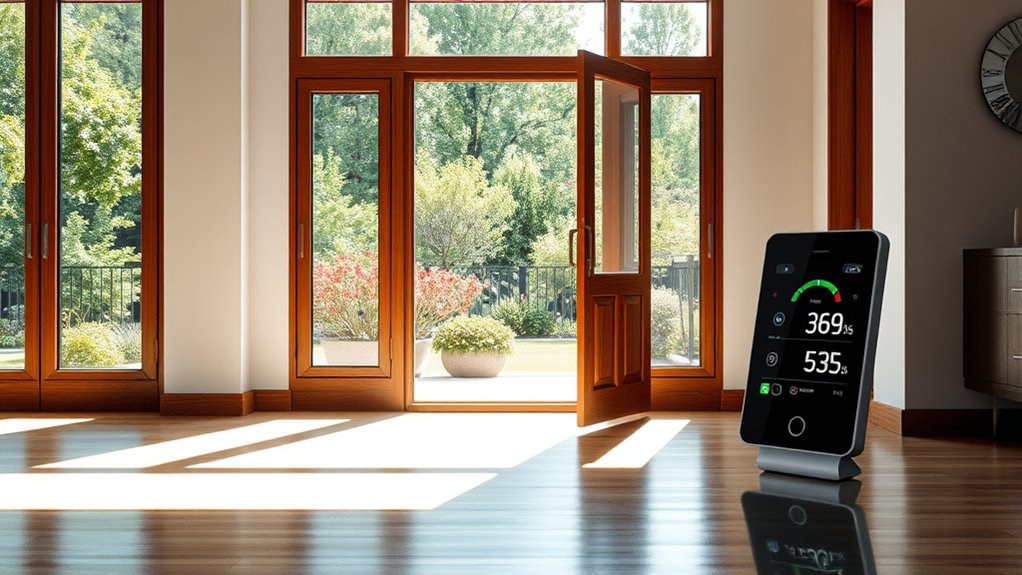Warming products enhance energy efficiency by minimizing heat loss and optimizing temperature control. Understanding metrics like U-value and Solar Heat Gain Coefficient (SHGC) is vital. Lower U-values indicate better insulation, while SHGC measures solar heat blockage. Choosing energy-efficient windows and doors can greatly reduce heating and cooling costs, improving overall comfort. By selecting low-emissivity glass and effective glazing options, you can maximize your building’s performance. Discover more about the science behind these essential elements.
Key Takeaways
- Warming products can enhance comfort, but their efficiency is significantly influenced by window and door energy performance in buildings.
- Energy-efficient windows reduce heating and cooling costs by preventing up to 61% of energy loss through inadequate insulation.
- Understanding U-values and Solar Heat Gain Coefficient (SHGC) is essential for selecting products that optimize energy efficiency and minimize heat loss.
- Low emissivity (Low-E) glass paired with double glazing offers superior insulation and reduces energy consumption for heating and cooling.
- Compliance with energy efficiency standards in product design contributes to improved overall building performance and long-term cost savings.
The Importance of Energy Efficiency in Fenestration

Energy efficiency is vital in fenestration, as windows and doors can account for a staggering 48-61% of heating and cooling energy loss in a building. This highlights the need for high-performing fenestration products.
By selecting energy-efficient windows during the design phase, you can markedly reduce energy consumption, potentially cutting household energy use for heating and cooling by up to 40%. Additionally, integrating smart technology integration into your heating systems can further enhance overall efficiency. Heat pumps can also significantly improve energy performance, providing effective heating and cooling solutions, especially when utilized in commercial applications that require consistent climate control. The implementation of proper insulation strategies can further mitigate energy loss through windows, ensuring a more comfortable indoor environment.
Selecting energy-efficient windows can reduce heating and cooling energy use by up to 40%.
Even a well-insulated building can lose heat if the windows are inefficient, so it’s important to focus on energy efficiency in your overall building design.
Understanding energy performance measures like U-value and Solar Heat Gain Coefficient (SHGC) will help you choose the right products and guarantee compliance with national construction codes, ultimately enhancing your building’s energy efficiency. Additionally, selecting energy-efficient heat pumps can further optimize your home’s heating and cooling system, reducing overall energy costs.
Understanding U-Value and Solar Heat Gain Coefficient (SHGC)

When choosing windows, understanding U-Value and Solar Heat Gain Coefficient (SHGC) is essential. The U-Value tells you how well a window insulates against heat loss, while the SHGC measures its ability to block unwanted solar heat. Additionally, selecting windows with high energy efficiency ratings can significantly reduce overall energy costs. Incorporating energy-efficient models can further enhance your home’s performance and lead to substantial savings on utility bills. By using solar energy solutions, homeowners can optimize energy use and further decrease their reliance on traditional energy sources. Furthermore, integrating heat pumps into your home can maximize energy efficiency and provide effective temperature control throughout the year. Additionally, considering smart home devices can enhance the overall energy management of your home, allowing for optimized heating and cooling processes.
U-Value Explained Simply
Understanding U-value and the Solar Heat Gain Coefficient (SHGC) is vital for anyone looking to improve their home’s energy efficiency. The U-value measures how much heat escapes through a window, with lower values indicating better insulation.
For Australian products, U-values typically range from 2 to 10 W/m²K. Choosing windows with low U-values is important because they help maintain thermal comfort and reduce energy bills.
Remember, U-values and R-values are inversely related; a higher R-value means better insulation, which corresponds to a lower U-value.
Energy assessors emphasize the importance of selecting windows with low U-values to guarantee compliance with national construction codes and achieve peak energy performance in your building design.
SHGC Importance in Design
While selecting the right windows for your home, the Solar Heat Gain Coefficient (SHGC) plays an essential role in energy efficiency. The SHGC measures how much solar radiation passes through a window, with lower values indicating better performance in reducing heat gain from direct sunlight.
For example, a window with an SHGC of 0.5 allows 50% of solar heat to enter, which can greatly affect your indoor comfort. Since windows can account for 48-61% of a building’s heating and cooling energy loss, choosing the appropriate SHGC is imperative.
Additionally, the type of glass used, like low emissivity glass, can enhance thermal performance when paired with double glazing.
Prioritize SHGC in your design decisions for ideal energy efficiency.
Comparing U-Value and SHGC
Both U-value and Solar Heat Gain Coefficient (SHGC) are essential metrics you need to take into account for optimizing your windows’ energy performance.
The U-value measures the rate of non-solar heat transfer, with lower values indicating better insulation. In Australia, typical U-values range from 2 to 10 W/m²K.
On the other hand, SHGC quantifies how effectively a window reduces heat from direct sunlight, expressed as a fraction between 0 and 1. A window with an SHGC of 0.5 allows 50% of solar heat to pass through.
To enhance energy efficiency, aim for products that combine low U-values with low SHGC values. This combination can markedly reduce energy costs while improving occupant comfort in your space.
R-Value vs. U-Value: Key Differences in Energy Performance

When it comes to energy performance, R-values and U-values play essential roles in determining how well a building retains heat or keeps it out.
Understanding these metrics is important for achieving energy savings in your home or building.
- R-value measures thermal resistance in insulation.
- Higher R-values improve insulation effectiveness.
- U-value quantifies heat transfer through windows.
- Lower U-values enhance window efficiency.
Exploring Glazing Options and the Benefits of Low Emissivity Glass

When choosing glazing options for your home, consider the advantages of low emissivity (Low-E) glass.
It effectively reflects infrared energy, helping you maintain comfortable temperatures year-round while cutting down on energy costs.
Glazing Types Comparison
Choosing the right glazing type can greatly impact your home’s energy efficiency and comfort.
When considering insulated windows, you have several options:
- Single glazing: Cost-effective but minimal insulation, suited for warmer climates.
- Double glazing: Two layers of glass that markedly enhance insulation; popular in southern Australia.
- Triple glazing: Three layers of glass provide superior energy efficiency, ideal for stringent energy regulations.
- Low Emissivity (Low-E) glass: Better than standard glass, but best combined with double glazing to improve thermal efficiency.
Selecting the right glazing type guarantees you maximize your home’s insulation, reduce energy costs, and enhance your living environment.
Each option has its benefits, so consider your climate and energy goals carefully.
Benefits of Low Emissivity
Understanding the various glazing options opens the door to the significant advantages of Low Emissivity (low-E) glass.
When you choose low-E glass for your windows and doors, you’re opting for a smart investment in energy efficiency. This special coating reflects heat back into your home during winter and keeps it out in summer, reducing energy loss by 30% to 50%.
By combining low-E glass with double glazing, you enhance thermal performance and overall insulation, which saves you money on heating and cooling costs. Unlike single glazing, low-E offers superior insulation value.
Plus, when paired with inert gas fills, the U-values drop even lower, helping you meet modern energy efficiency standards effortlessly.
The Impact of Windows on Building Thermal Performance

Since windows and doors play a pivotal role in a building’s thermal performance, their energy efficiency can greatly impact heating and cooling costs.
Windows and doors are crucial for thermal performance, significantly influencing heating and cooling expenses.
In fact, they account for 48-61% of energy usage in heating and cooling. Understanding key factors can help you make informed choices:
- U-value: Lower values mean better insulation.
- Solar Heat Gain Coefficient (SHGC): Lower values reduce solar heat transmission.
- Double glazing: Enhances insulation and minimizes heat loss.
- External shading: Devices like awnings can improve energy performance.
Recommendations for Selecting Energy-Efficient Windows and Doors

When selecting energy-efficient windows and doors, it’s essential to focus on key performance metrics that influence your home’s comfort and energy costs.
Start by prioritizing windows with lower U-values, which indicate better insulation and reduced heat loss. Look for an SHGC of 0.5 or lower to limit solar heat transmission, enhancing your thermal comfort.
Opt for double glazing, as it markedly improves insulation and is now common in over 50% of southern Australia’s new builds. Incorporating low-emissivity (low-E) glass with double glazing further boosts thermal performance by reducing heat transfer.
Finally, consider integrating energy-efficient window systems early in your design to comply with national construction codes, ultimately optimizing your home’s energy use.
Frequently Asked Questions
What Is Energy Efficiency Science?
Energy efficiency science focuses on how you can optimize energy use to cut down consumption while still enjoying the same level of service.
It involves understanding metrics like U-value and R-value, which measure the thermal performance of materials.
By implementing cost-effective measures, you can greatly lower greenhouse gas emissions and reduce your household energy consumption for heating and cooling.
How Does Energy Efficiency Help Global Warming?
Did you know that implementing energy efficiency measures could cut global greenhouse gas emissions by over 40%?
When you embrace energy efficiency, you’re not just saving on bills; you’re actively combating climate change. By reducing energy consumption, you lower carbon emissions markedly, helping to keep the planet cooler.
Each small change you make contributes to a larger collective effort, making an essential difference in our fight against global warming and securing a sustainable future.
What Is the Science of Efficiency?
The science of efficiency focuses on optimizing processes to minimize energy consumption while maintaining performance.
You can achieve this by using advanced materials and technologies that reduce waste and improve insulation.
By understanding metrics like U-value and R-value, you can make informed decisions about building and product design.
When you implement these strategies, you not only enhance productivity but also contribute to reducing greenhouse gas emissions, benefiting both the environment and your bottom line.
Why Aren’t Any Energy Conversions 100% Efficient?
Energy conversions aren’t 100% efficient because of the laws of thermodynamics.
You can’t create or destroy energy, and when energy transforms, some always gets lost as heat due to friction or resistance.
For instance, when you use an electric motor, it might only operate at 85-95% efficiency. The rest of the energy dissipates as heat, showing that no process can achieve perfect efficiency.
It’s a fundamental limitation of how energy works.
Conclusion
To sum up, investing in energy-efficient windows and doors is like planting seeds for a greener future. By understanding U-Value, SHGC, and the benefits of low emissivity glass, you can make informed choices that elevate your home’s thermal performance. Remember, every small step counts—choosing the right fenestration can lead to significant energy savings and a more comfortable living space. So, embrace energy efficiency, and watch your comfort and savings bloom!










